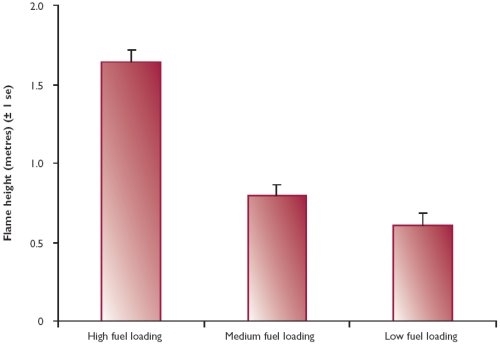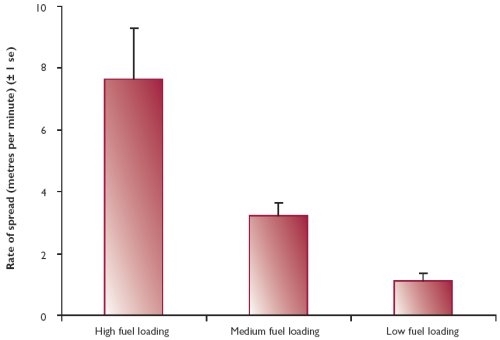Key findings
-
There is a clear relationship between the amount of fuel and fire intensity.
-
It is very difficult to achieve a 'clean' burn even with the most intense management fires.
-
Over the last three years, in collaboration with the University of Edinburgh and Scottish Natural Heritage (SNH), we have been investigating the nature of fires that occur during muirburn.
-
We are developing models to predict fuel moisture, the impact of moisture content on flammability and heather regeneration, and we are testing existing fire risk models to see whether they can be developed as tools for land managers.
 We conducted a series of experiments involving 18 fires over two years on Ralia and Crubenmore moors. These experiments have examined interactions between fireline intensity (a measure of fire/heat output and controllability) and fire impact, and how these are affected by fuel loading (the amount of heather present) and variations in weather conditions. Analysis of the data is at an early stage, but we have found a number of relationships.
We conducted a series of experiments involving 18 fires over two years on Ralia and Crubenmore moors. These experiments have examined interactions between fireline intensity (a measure of fire/heat output and controllability) and fire impact, and how these are affected by fuel loading (the amount of heather present) and variations in weather conditions. Analysis of the data is at an early stage, but we have found a number of relationships.
There is a clear effect of fuel loading on components of fireline intensity such as flame height and rate of spread: fires are more intense and spread faster where there is more fuel (see Figures 1 and 2). More detailed analysis will allow us to provide predictions of fire behaviour based on specific fuel loads and weather conditions.
There is a significant relationship between flame height and rate of spread: faster moving fires generally have taller flames. Fast moving fires with tall flames are not just caused by higher wind speeds - fuel available and slope angle in relation to the fire direction also affect the rate of spread and observed fire height. With more data, this relationship could be turned into a simple field guide to how fire spreads. It will then be possible to identify rapidly the fires that are likely to move too quickly to control and extinguish them.
Findings such as these demonstrate the rather obvious conclusion that where there is more fuel, fires are hotter! However, one of the most important aspects of this research has been to understand the rather complicated variability in behaviour that lies both within and between different fires (this is well demonstrated by the wide error bars on Figures 1 and 2). We have used in-depth monitoring before, during and after the fires to produce data that enable us to understand this and, crucially, to develop links between the intensity of a fire and its impacts on the ground.
Figure 1: Average flame height of fires in three fuel classes

Figure 2: Average rate of spread of fires in three fuel classes

For example, we have used a variety of techniques to measure rates of temperature change at different levels in the vegetation (canopy, ground level and two centimetres below-ground). We found that extensive heating just a couple of centimetres below ground level is rare (see Table 1). This is important as temperatures above 50ºC are likely to be lethal to heather plants.
Table 1: Average (± 1se) temperature (°C) reached in heather fires at canopy height, ground level and two centimetres below ground in high, medium and low fuel loadings
| Fuel load |
Canopy |
Ground |
Buried |
| High |
653 (34) |
322 (50) |
8 (4) |
| Medium |
688 (24) |
375 (56) |
6 (2) |
| Low |
516 (77) |
253 (84) |
38 (32) |
The data show that although the deep moss layers found beneath many older heather stands may be killed by fires, they are not burnt away (the average moss depth removed from all fires was just 2.1±0.7mm). It is difficult to achieve a 'clean' burn even with relatively intense fires. Good regeneration from seed is important in older stands, but moss mats (dead or alive) provide poor seedbeds.
Combining these analyses suggests that there may be significant problems with burning large areas of rank heather. Big fires in such stands will be difficult to control and regeneration of younger heather poor. A solution could be combination cutting (for firebreaks and regeneration) or double-burning the heather at small scales. Essentially much old heather could be left unburnt with only small areas of old stand being burnt or cut on rotation in such a way to ensure good heather regeneration. Public agencies are increasingly turning their attention to the practice of muirburn and there is no room for complacency, but there are many possibilities for developing good practice.